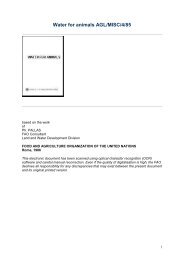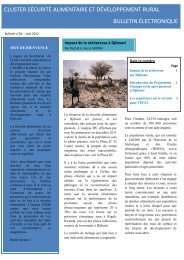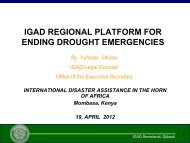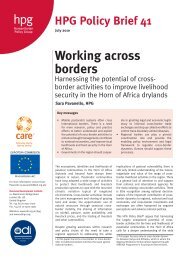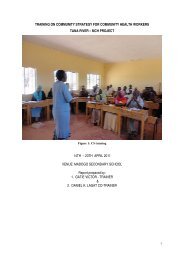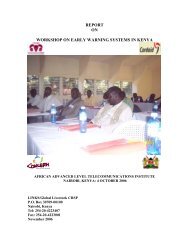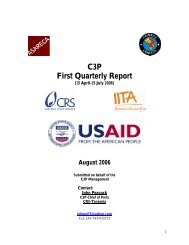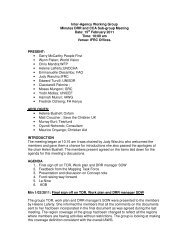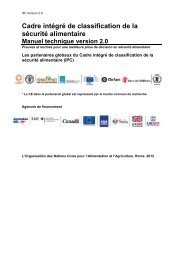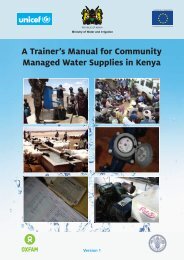Major elements <str<strong>on</strong>g>of</str<strong>on</strong>g> <strong>the</strong> PSNP PAP include:• Timing <str<strong>on</strong>g>of</str<strong>on</strong>g> projects adjusted to <strong>the</strong> seas<strong>on</strong>ality <str<strong>on</strong>g>of</str<strong>on</strong>g> livelihoods in <strong>the</strong> lowl<str<strong>on</strong>g>and</str<strong>on</strong>g>s;• Pilot woredas implement opti<strong>on</strong>s suitable to local circumstances;• Projects identified with participati<strong>on</strong> from different livelihood groups <str<strong>on</strong>g>and</str<strong>on</strong>g> resp<strong>on</strong>d to communityneeds - backstopped by technical expertise;• Public works developed in <strong>the</strong> c<strong>on</strong>text <str<strong>on</strong>g>of</str<strong>on</strong>g> livelihood <str<strong>on</strong>g>and</str<strong>on</strong>g> l<str<strong>on</strong>g>and</str<strong>on</strong>g>scape z<strong>on</strong>es so as not to interferewith mobility systems <str<strong>on</strong>g>and</str<strong>on</strong>g> instigate competiti<strong>on</strong> between different groups;• Social <str<strong>on</strong>g>and</str<strong>on</strong>g> envir<strong>on</strong>mental impacts c<strong>on</strong>sidered;• Clans <str<strong>on</strong>g>and</str<strong>on</strong>g> communities c<strong>on</strong>sulted to ensure that access <str<strong>on</strong>g>and</str<strong>on</strong>g> use rights are not encroached up<strong>on</strong>,<str<strong>on</strong>g>and</str<strong>on</strong>g> that ownership/management structures are discussed which should “follow traditi<strong>on</strong>alcommunal management structures, toge<strong>the</strong>r with traditi<strong>on</strong>al user rights” (Ministry <str<strong>on</strong>g>of</str<strong>on</strong>g> Agriculture<str<strong>on</strong>g>and</str<strong>on</strong>g> Rural Development Food Security Programme 2010-2014, 2009: p.57). Range management<str<strong>on</strong>g>and</str<strong>on</strong>g> range ecology experts at woreda <str<strong>on</strong>g>and</str<strong>on</strong>g> regi<strong>on</strong>al level also c<strong>on</strong>sulted to ensure thatdevelopment does not lead to range overuse <str<strong>on</strong>g>and</str<strong>on</strong>g> degradati<strong>on</strong>;• Partnerships between woredas <str<strong>on</strong>g>and</str<strong>on</strong>g> NGOs piloted to address capacity shortages at woreda level;• A Pastoral Taskforce, c<strong>on</strong>stituting Government, d<strong>on</strong>ors <str<strong>on</strong>g>and</str<strong>on</strong>g> o<strong>the</strong>r stakeholders, set up tocoordinate planning <str<strong>on</strong>g>and</str<strong>on</strong>g> implementati<strong>on</strong>;• Mobility <str<strong>on</strong>g>and</str<strong>on</strong>g> access to critical natural resources supported to increase resilience to drought. TheMoARD led Nati<strong>on</strong>al Livestock Policy Forum is currently drafting four drought protocols forpastoral areas to clearly define modalities <strong>on</strong> how to achieve this;• Applied studies <str<strong>on</strong>g>of</str<strong>on</strong>g> range <str<strong>on</strong>g>and</str<strong>on</strong>g> water management carried out in <strong>on</strong>e or two woredas to provideguidelines for approaching district level water <str<strong>on</strong>g>and</str<strong>on</strong>g> range management planning, to serve as amodel for scaling up;• Natural resource <str<strong>on</strong>g>and</str<strong>on</strong>g> socio-ec<strong>on</strong>omic mapping <str<strong>on</strong>g>and</str<strong>on</strong>g> analysis used.Types <str<strong>on</strong>g>of</str<strong>on</strong>g> projects to be implemented should be disaggregated based <strong>on</strong> settlement patterns indifferent areas. In pastoral areas with high mobility <str<strong>on</strong>g>and</str<strong>on</strong>g> irregular use <str<strong>on</strong>g>of</str<strong>on</strong>g> services, projects shouldfocus <strong>on</strong> envir<strong>on</strong>mental rehabilitati<strong>on</strong>, natural resource mapping <str<strong>on</strong>g>and</str<strong>on</strong>g> community acti<strong>on</strong> planning (Box9), improved access to water sources, <str<strong>on</strong>g>and</str<strong>on</strong>g> improved water management, possibly includingreducti<strong>on</strong> <str<strong>on</strong>g>of</str<strong>on</strong>g> some poorly sited water sources. For agro-pastoralists <str<strong>on</strong>g>and</str<strong>on</strong>g> o<strong>the</strong>rs who are semisettled,interventi<strong>on</strong>s should include <strong>the</strong> development <str<strong>on</strong>g>of</str<strong>on</strong>g> service infrastructure (schools, clinics, etc.),water supplies for human c<strong>on</strong>sumpti<strong>on</strong>, <str<strong>on</strong>g>and</str<strong>on</strong>g> water development for irrigati<strong>on</strong>.Applying a livelihood z<strong>on</strong>e approach ra<strong>the</strong>r than a kebele based approach to public works planningshould be c<strong>on</strong>sidered <str<strong>on</strong>g>and</str<strong>on</strong>g> guidelines developed accordingly specific to <strong>the</strong> pastoral c<strong>on</strong>text. Thisapproach involves “c<strong>on</strong>sidering migrati<strong>on</strong> patterns <str<strong>on</strong>g>and</str<strong>on</strong>g> grazing l<str<strong>on</strong>g>and</str<strong>on</strong>g>/water point usage ra<strong>the</strong>r thansimply administrative boundaries.” (Ministry <str<strong>on</strong>g>of</str<strong>on</strong>g> Agriculture <str<strong>on</strong>g>and</str<strong>on</strong>g> Rural Development Food SecurityProgramme 2010-2014, 2009: p.57). The preparati<strong>on</strong> <str<strong>on</strong>g>of</str<strong>on</strong>g> Community Acti<strong>on</strong> Plans 34 around livelihoodz<strong>on</strong>es could be a promising practice, <str<strong>on</strong>g>and</str<strong>on</strong>g> involving whole affected communities at z<strong>on</strong>al or interworedalevel (not just kebele residents) in site selecti<strong>on</strong> is critical to avoid development inducedc<strong>on</strong>flict. Z<strong>on</strong>al level administrati<strong>on</strong> can play an important coordinati<strong>on</strong> role, especially as livelihoodz<strong>on</strong>es, clans <str<strong>on</strong>g>and</str<strong>on</strong>g> customary instituti<strong>on</strong>s cross district borders.Traditi<strong>on</strong>al instituti<strong>on</strong>s are also explicitly menti<strong>on</strong>ed. The Gada system in Oromia, <strong>the</strong> Guurti <str<strong>on</strong>g>and</str<strong>on</strong>g> clanelders in Somali, <str<strong>on</strong>g>and</str<strong>on</strong>g> <strong>the</strong> Medaa in Afar are recognized to play an important role in communities, <str<strong>on</strong>g>and</str<strong>on</strong>g><strong>the</strong>ir role in <strong>the</strong> PSNP is envisi<strong>on</strong>ed as:• Helping, where needed, in identifying beneficiaries;• Helping ensure that public works implemented in <strong>the</strong> rangel<str<strong>on</strong>g>and</str<strong>on</strong>g>s or in close proximity to water,are compatible with extensive livestock producti<strong>on</strong>;34 Where communities identify <strong>the</strong>ir own development needs.54
• Help ensure that public works do not encroach <strong>on</strong> customary rights <str<strong>on</strong>g>of</str<strong>on</strong>g> access or use;• Support <strong>the</strong> resoluti<strong>on</strong> <str<strong>on</strong>g>of</str<strong>on</strong>g> issues regarding l<strong>on</strong>g-term ownership or management.Box 9: Use <str<strong>on</strong>g>of</str<strong>on</strong>g> Natural Resource <str<strong>on</strong>g>and</str<strong>on</strong>g> Socio Ec<strong>on</strong>omic Mapping <str<strong>on</strong>g>and</str<strong>on</strong>g> Analysis in PSNP (from DraftGuidelines for <strong>the</strong> Implementati<strong>on</strong> <str<strong>on</strong>g>of</str<strong>on</strong>g> <strong>the</strong> Productive Safety Net Program Pastoral Areas Pilot,Versi<strong>on</strong> 2, 2007: 52)A Development Agent (DA) will use simple mapping kits to bring <strong>on</strong> board local knowledge as brought to <strong>the</strong>table by <strong>the</strong> planning team - comprised <str<strong>on</strong>g>of</str<strong>on</strong>g> <strong>the</strong> community leader at kebele level, four male headed householdsrepresenting different social groups, four female headed households representing different social groups, <strong>on</strong>eyouth representative, <strong>on</strong>e religious representative, <str<strong>on</strong>g>and</str<strong>on</strong>g> o<strong>the</strong>rs as required by <strong>the</strong> community.The process involves:• Marking obvious features <strong>on</strong> <strong>the</strong> ground, which could be <strong>the</strong> pastoral unit boundaries, roads, hill tops,rivers, settlements, etc.• Adding more detail to <strong>the</strong> map which includes <strong>the</strong> locati<strong>on</strong> <str<strong>on</strong>g>of</str<strong>on</strong>g> different natural resources such as pasture,water sources, agricultural l<str<strong>on</strong>g>and</str<strong>on</strong>g>, forest, etc. <str<strong>on</strong>g>and</str<strong>on</strong>g> any areas where degradati<strong>on</strong> is observed. At this stage,features <str<strong>on</strong>g>of</str<strong>on</strong>g> traditi<strong>on</strong>al natural resource management should be marked, including customary l<str<strong>on</strong>g>and</str<strong>on</strong>g> divisi<strong>on</strong>sfor grazing management, customary water management arrangements, <str<strong>on</strong>g>and</str<strong>on</strong>g> patterns <str<strong>on</strong>g>of</str<strong>on</strong>g> mobility (<str<strong>on</strong>g>of</str<strong>on</strong>g> bothlocal <str<strong>on</strong>g>and</str<strong>on</strong>g> visiting communities).• Identify <str<strong>on</strong>g>and</str<strong>on</strong>g> discuss any problems which exist in relati<strong>on</strong> to mapped items, including natural resources,traditi<strong>on</strong>al systems, mobility, <str<strong>on</strong>g>and</str<strong>on</strong>g> c<strong>on</strong>flict. Different maps can be produced to capture different aspects, forexample a map for natural resources, <strong>on</strong>e for social services <str<strong>on</strong>g>and</str<strong>on</strong>g> <strong>on</strong>e for mobility.• Jointly prioritize issues to be addressed, identify potential soluti<strong>on</strong>s <str<strong>on</strong>g>and</str<strong>on</strong>g> identify community/external (publicworks) acti<strong>on</strong>s which can rectify <strong>the</strong> problem.•Prioritized public works as identified through <strong>the</strong> above planning process should <strong>the</strong>n be presented, discussed,amended <str<strong>on</strong>g>and</str<strong>on</strong>g> approved in a general assembly representing <strong>the</strong> wider community. Agreed up<strong>on</strong> public worksshould <strong>the</strong>n be included in <strong>the</strong> kebele plan which is submitted to woreda level for approval. The kebele planshould include a short technical descripti<strong>on</strong> <str<strong>on</strong>g>of</str<strong>on</strong>g> proposed projects, a list <str<strong>on</strong>g>of</str<strong>on</strong>g> intended activities, <strong>the</strong> number <str<strong>on</strong>g>of</str<strong>on</strong>g>participants in <strong>the</strong> implementati<strong>on</strong> process <str<strong>on</strong>g>and</str<strong>on</strong>g> <strong>the</strong>ir levels <str<strong>on</strong>g>of</str<strong>on</strong>g> effort, requirements for technical <str<strong>on</strong>g>and</str<strong>on</strong>g>administrative input, <str<strong>on</strong>g>and</str<strong>on</strong>g> a maintenance plan for new infrastructure.The PSNP PAP Progress Report, published in 2008, identified some weaknesses in pilotimplementati<strong>on</strong>, which include:• Overall delayed implementati<strong>on</strong> <str<strong>on</strong>g>and</str<strong>on</strong>g> weak recruitment <str<strong>on</strong>g>of</str<strong>on</strong>g> necessary staff;• Training <strong>on</strong> implementati<strong>on</strong> guidelines was incomplete;• Even though NGOs are <strong>on</strong> board <strong>the</strong>re is need for better coordinati<strong>on</strong>;• Program activities were not sufficiently explained to communities in pilot woredas;• No informati<strong>on</strong> available whe<strong>the</strong>r regi<strong>on</strong>al government <str<strong>on</strong>g>and</str<strong>on</strong>g> NGOs have held appropriatediscussi<strong>on</strong>s with target communities to generate informati<strong>on</strong> regarding situati<strong>on</strong> assessments in<strong>the</strong> pilot woredas, or to decide <strong>on</strong> pilot opti<strong>on</strong>s to suit local c<strong>on</strong>texts.• Many <str<strong>on</strong>g>of</str<strong>on</strong>g> <strong>the</strong> planning activities had not yet been implemented <str<strong>on</strong>g>and</str<strong>on</strong>g> little informati<strong>on</strong> provided <strong>on</strong>progress with regards to identifying beneficiaries or deciding which public works to carry out.• A change <str<strong>on</strong>g>of</str<strong>on</strong>g> PSNP staff occurred in Somali regi<strong>on</strong> with limited awareness <str<strong>on</strong>g>and</str<strong>on</strong>g> underst<str<strong>on</strong>g>and</str<strong>on</strong>g>ing <str<strong>on</strong>g>of</str<strong>on</strong>g>pilot objectives.• No <str<strong>on</strong>g>of</str<strong>on</strong>g>ficial reports had been submitted ei<strong>the</strong>r by government or by NGOs related to progress<strong>on</strong> training implemented <str<strong>on</strong>g>and</str<strong>on</strong>g> pilot opti<strong>on</strong>s.• Weak coordinati<strong>on</strong> <str<strong>on</strong>g>and</str<strong>on</strong>g> informati<strong>on</strong> sharing between regi<strong>on</strong>al government <str<strong>on</strong>g>and</str<strong>on</strong>g> NGOs, <str<strong>on</strong>g>and</str<strong>on</strong>g> nocoordinati<strong>on</strong> mechanisms in place in pastoral regi<strong>on</strong>s.A final assessment <str<strong>on</strong>g>of</str<strong>on</strong>g> <strong>the</strong> pilot phase is currently being undertaken. However, <strong>the</strong>re is pressure toimplement <strong>the</strong> next phase <str<strong>on</strong>g>of</str<strong>on</strong>g> <strong>the</strong> PSNP (current phase ended in 2009), <str<strong>on</strong>g>and</str<strong>on</strong>g> Government plans to rollout <strong>the</strong> PSNP PAP in 2010. In turn <strong>the</strong>re is a risk that less<strong>on</strong>s from <strong>the</strong> final assessment may not befully integrated into <strong>the</strong> planning <str<strong>on</strong>g>and</str<strong>on</strong>g> roll-out <str<strong>on</strong>g>of</str<strong>on</strong>g> <strong>the</strong> full PSNP for pastoral areas. Therefore less<strong>on</strong>55
- Page 1 and 2:
Synthesis
- Page 4 and 5: TABLE OF CONTENTSLIST OF ACRONYMS..
- Page 6 and 7: ACKNOWLEDGMENTSI would like to exte
- Page 8 and 9: LIST OF ACRONYMSACDI/VOCAACFAFDCDDC
- Page 10 and 11: EXECUTIVE SUMMARYWater development
- Page 12 and 13: understanding <str
- Page 14 and 15: Agreed upon guidelines for water de
- Page 16 and 17: • Make better use of</str
- Page 18 and 19: to inform their own work an
- Page 20 and 21: Within pastoral areas, it is recogn
- Page 23 and 24: Section 2. Overview of</str
- Page 25 and 26: Dohrn, 2006). Spatially variable ra
- Page 27 and 28: The following broad overview touche
- Page 29 and 30: In areas of adequa
- Page 31 and 32: observed response was for individua
- Page 33 and 34: Specific to water development, seve
- Page 35 and 36: Section 3. Water development todayT
- Page 37 and 38: Eliciting payments for water from l
- Page 39 and 40: ureaus 25 . The ministry’s interv
- Page 41 and 42: National policy paints a conflictin
- Page 43 and 44: will be given to pastoralists to en
- Page 45 and 46: Water supplyGovernance and<
- Page 47 and 48: vulnerable to conversion for other
- Page 49 and 50: • Agro-pastoralists’ priorities
- Page 51 and 52: Although the WSDP principles are se
- Page 53: The Universal Access ProgramThe Uni
- Page 57 and 58: However, the development model for
- Page 59 and 60: Figure 4: Proposed pilot la
- Page 61 and 62: Many international and</str
- Page 63 and 64: Furthermore, attention is given to
- Page 65 and 66: CARE International, under the GWI,
- Page 67: and traditional me
- Page 70 and 71: • Understand exi
- Page 72 and 73: 4.2 Key observations in the water d
- Page 74 and 75: epresent a firm attempt to preserve
- Page 76 and 77: learning from NGO experiences in Bo
- Page 78 and 79: However, there are currently no spe
- Page 80 and 81: 4.3 Conclusion, ways forward <stron
- Page 82 and 83: In sum, pastoralism as a livelihood
- Page 84 and 85: • Water interventions selected sh
- Page 86 and 87: • Promote effective participation
- Page 88 and 89: Gebre-Mariam, A. (1982). Organizati
- Page 90: Schimann P. and Ph



